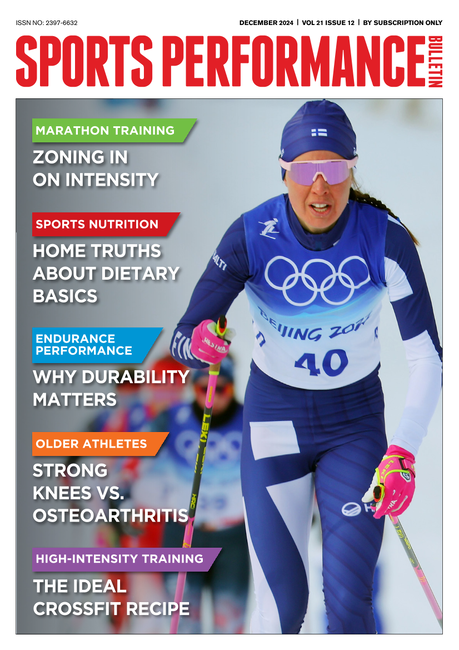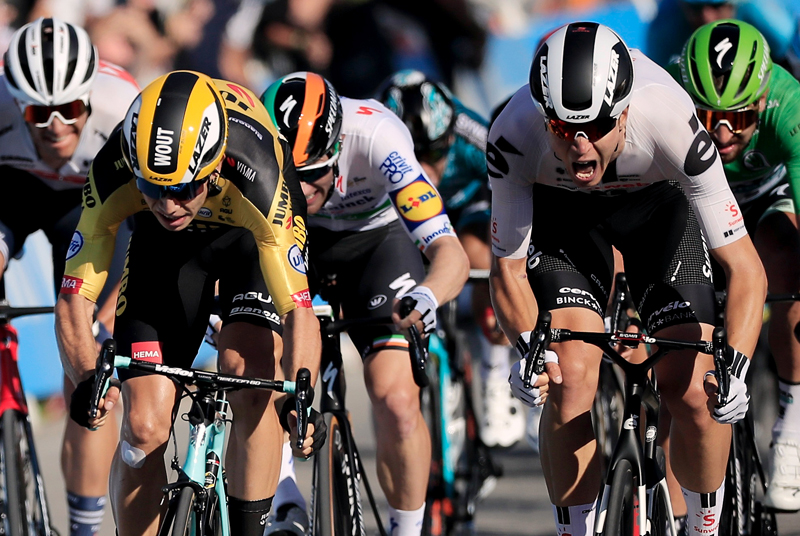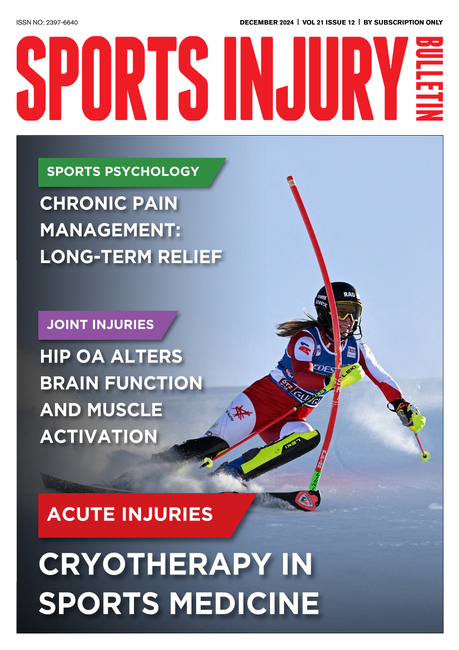
Endurance athletes face an interesting paradox when it comes to muscle mass. Bigger, stronger muscles generate more forceful contractions, resulting in higher power and greater speed. However, the weight of bulky muscles imposes greater demands on our limited energy stores, especially in weight-bearing sports. But as Professor Mike Saunders explains, maintaining adequate sport-specific muscle mass is critical for optimal performance in endurance athletes.
Let’s begin by clarifying why muscle mass is important for endurance athletes:
- Higher peak power output – Some endurance sports, such as marathon running, are performed at relatively constant, moderate intensities. As a result, peak power is of secondary importance in these events. However, shorter high-intensity bursts are often needed to power over hills, successfully execute breakaways and win sprints. If you have higher peak power, you will be more successful in these endeavours;
- Lower relative muscular effort – Every sport movement (ie a running stride at a certain speed) produces a given amount of force on your muscles. By increasing muscular strength, this same force becomes a lower percentage of your maximum effort, prolonging your muscular endurance. This effect is largest in individuals who are the weakest. For example, strength training alone, without any cardiovascular training, can increase the treadmill endurance of the elderly;
- Reduced injury risk – Stronger muscles are more capable of withstanding the potentially injury-producing forces that inevitably occur in sport. It is widely believed that increasing muscular strength can reduce the risk for sport-related injuries.
How much muscle does an endurance athlete need?
Scientists use the terms mesomorph and ectomorph to describe the extremes of muscularity in athletes (see PP 251 – Ed). Pure mesomorphs, such as body builders, are heavy athletes with lots of muscle mass, while pure ectomorphs are light athletes with low levels of fat and muscle. Endurance athletes tend to be quite ectomorphic compared to other athletes. However, this should not be misinterpreted to assume that skinnier is always better!Jargonbuster
Mesomorph = An individual with high muscularity; the opposite of an ectomorphEctomorph = A person with low levels of muscle mass. Endurance athletes, especially in weight-bearing sports, tend to be among the most ectomorphic competitive athletes.
Protein balance = The balance between protein synthesis (building new protein structures, such as muscle) and protein degradation (breakdown of protein structures in the body).
The optimal amount of muscularity for an endurance athlete will depend on a variety of factors, including the length and intensity of the event, the mode of locomotion in the sport, and numerous other factors. In general, higher muscularity is more beneficial in events that are shorter in duration, events requiring high-intensity bursts of power, and in sports where body weight is supported, minimising the effects of gravity. Thus, we usually observe greater muscularity in swimmers, sprint/track cyclists, and team-sport endurance athletes such as football players. By comparison, distance runners and ‘climbing-specialist’ cyclists tend to be among the most ectomorphic athletes (see figure 1).
A good comparative example is provided in professional cycling, where time-trial specialists tend to have weight/height ratios of approximately 2.5lbs per inch of height (ie former Tour de France prologue winners Fabian Cancellara and Thor Hushovd have reported ratios of 2.4-2.5) while climbing specialists tend to be closer to about 2.0lbs per inch (the three top climbers in this year’s Tour; Michael Rasmussen, Mauricio Soler, and Alberto Contador have ratios of approximately 1.9-2.0). The greater muscle mass of the time trialists allows them to generate more power (and thus speed) than the lighter climbers during flat time trials, but their added muscle mass becomes a disadvantage in the mountains, where the forces of gravity encountered during long climbs slows the heavier riders.
In summary, muscle mass is critical for the performance of all endurance athletes, but its importance, and thus the amount of time you should devote to training to develop muscle mass is related to the specific demands of your event. However, even for the featherweight athlete, maintenance of adequate sport-specific muscle mass is crucial for performance. Adequate muscle mass allows you to generate higher power outputs, produce lower muscular efforts during sub-maximal workloads, and may enhance injury resistance.
Dietary strategies for building/maintaining muscle mass
Don’t neglect the carbohydrates – When you think about building muscle, protein is the ingredient that immediately comes to mind, and this nutrient will be the focus of much further discussion here. However, be careful not to neglect carbohydrate intake in your quest for adequate protein. Endurance sports create a very high demand for energy, and the process of muscle building also requires considerable energy. Our bodies use carbohydrate as their primary fuel during most endurance activities, and it is known that inadequate consumption of dietary carbohydrate can lead to depletion of your valuable muscle glycogen stores.The ‘low-carb’ diet craze of the past decade may have some of you second-guessing your needs for dietary carbohydrates. In case you need another reason to consume your carbs, a study from researchers at the University of Birmingham (England) examined distance runners who were performing 11 days of intensified training on low (40%) and high (70%) carbohydrate diets(1). When consuming the higher carbohydrate diet, the runners maintained much better endurance performance and fewer symptoms of overtraining, even though the calories were matched between the two diets. The bottom line: if you are performing intensive endurance training, don’t skimp on the carbohydrates!
Importance of consuming protein – Protein is in a constant state of turnover in the body, with protein synthesis (building of new protein structures, including muscle) occurring in tandem with protein degradation (the breakdown of body proteins). If your goal is to maintain your existing muscle mass, you must strive for a state of protein balance, where the daily losses of protein through degradation are offset by equal gains in protein synthesis. If muscle building is desired, you must sustain a period where protein synthesis outweighs protein breakdown. Scientists are beginning to study how protein intake can influence protein balance in endurance athletes. In addition, the roles of dietary protein on muscle damage, muscle glycogen replenishment and subsequent exercise performance have been recently studied.
Improved protein balance
Exercise stimulates protein synthesis but it also increases the rate of protein breakdown. Researchers at Maastricht University (The Netherlands) examined protein balance in endurance athletes during six hours of cycling/running(2). When carbohydrate was consumed at 30-minute intervals throughout exercise, protein balance remained in a negative state throughout exercise and during four hours of post-exercise recovery. However, when a mix of carbohydrate and protein was consumed during the exercise, protein synthesis was increased and protein breakdown was decreased, resulting in a positive protein balance during and following exercise (see figure 2). This study suggests that even with adequate carbohydrate consumption, endurance training can create a catabolic state for the muscles if protein intake is not adequate. So, consuming some protein along with your carbohydrates during/following long endurance events can improve your protein balance.Muscle damage
A number of recent studies from our laboratory at James Madison University (USA) have shown that consuming mixes of carbohydrate and protein during or following exercise can reduce markers of muscle damage and muscle soreness following heavy endurance exercise. These findings have been observed when carbohydrate-protein drinks were consumed following exhaustive bouts of cycling(3,4), as well as following the daily training sessions of cross-country runners(5).Interestingly, we also observed an association between the mileage the runners were performing, and the amount of benefit they received from the protein. In other words, the harder you train, the more potential you create for muscle damage and the more important it is that you consume a mix of carbohydrate-protein immediately following training sessions.
Muscle glycogen replenishment
Investigators from the University of Texas have reported that consumption of carbohydrate-protein following exercise speeds the rate of muscle glycogen replenishment after exercise compared to carbs alone(6). However, other researchers have suggested that these effects could also be obtained with frequently repeated doses of carbohydrate throughout recovery. While this may be possible, high-frequency carbohydrate dosing may be impractical, and could lead to high levels of calorie consumption, which may have implications for weight management and other dietary issues.While scientists will continue to investigate this issue, it appears that when moderate doses of calories are consumed following exercise, a combination of carbohydrate and protein ingestion provides equal or superior rates of glycogen replenishment versus carbohydrates alone. When you consider the added benefits of improved protein balance and reductions in muscle damage, a post-exercise mix of carbohydrate and protein seems a desirable choice for athletes performing endurance training (see figure 3).
Carbohydrate-protein and subsequent performance
A few studies have reported that carbohydrate-protein consumption during recovery from exercise can improve your performance in subsequent exercise(4,7,8). Although other researchers have not reported benefits in subsequent performance with carbohydrate-protein ingestion(9,10), the variation in these findings may be related to differing effects of the initial exercise bout. For example, if the initial exercise session does not produce a significant amount of muscle damage or glycogen depletion, then it is unlikely that any supplement will improve subsequent performance because you can recover adequately without it.This concept is supported by a previously mentioned study, in which we observed that high-mileage runners had greater potential for reduced muscle damage and improved performance in subsequent exercise than low-mileage runners(5). In short, if you are training hard, consuming some carbohydrate-protein immediately following your exercise session could help your muscles recover faster, and allow you to perform better the next day. If you never train hard enough to really tax your muscles, then the potential recovery benefits are less significant, and will not likely influence performance in the short term.
Different protein types
Proteins are groupings of amino acids, and come in many forms. The roles and processes of these amino acids in the body are incredibly numerous and varied. Many nutritional products tout the benefits of essential amino acids (EAA). In particular, branched-chain amino acids (BCAA), a subgroup of EAAs, are commonly added to nutritional products and claim to build muscle and promote recovery.Although some studies have shown that BCAA supplementation promotes various aspects of muscle recovery, there does not appear to be strong evidence that their recovery properties are superior to whole proteins, as long as your protein contains similar levels of BCAA. For example, it is likely that the benefits of BCAA supplementation could be attained via whole protein supplements (whey, casein, etc) and other foods (chicken breasts, peanuts, milk products, etc) containing adequate levels of BCAA. Thus, while BCAAs may have some positive muscle building and recovery effects, there does not currently appear to be a clear justification for the higher costs of these supplements for endurance athletes.
Creatine and HMB
Creatine is very widely used by athletes in strength and power sports, and is discussed in more detail elsewhere in this issue. Endurance athletes who need to build more muscle for optimal performance may consider the supplementation of creatine. However, you should be cautioned that at least one study has reported a decline in endurance performance with creatine supplementation, perhaps due to weight gains from water retention.Thus, the decision to use creatine may depend on various characteristics of the athlete. For example, do you participate in a non-weight bearing sport like swimming or track cycling? Does your sport emphasise high-intensity bursts? Are you a vegetarian (making you more likely to have low creatine levels)? If these answers are yes, then creatine supplementation is more likely to be effective for you.
Another caution: although no research studies have reported detrimental health effects, the American College of Sports Medicine warns that there is no assurance that creatine supplementation is free from health risks, as anecdotal reports have suggested an association between creatine supplementation and various ailments ranging from muscle cramps to alterations in liver and kidney function(11).
HMB (beta-hydroxy-beta-methylbutyrate) is another supplement widely used by body builders due to claims of increased lean body mass and improved recovery. However, most evidence suggests that the potential improvements in lean body mass and strength with HMB are quite small, even in strength athletes receiving relatively high doses. Thus, it seems unlikely that most endurance athletes would receive noticeable benefits from the comparably small amounts of HMB that are in most commercially available recovery products.
It should be clear that carbohydrates and protein are important nutrients for endurance athletes, but how much should you eat, and when? While it is impossible to provide complete nutritional advice so briefly, perhaps the most important advice is to take advantage of your ‘post-exercise recovery window’.
Window of opportunity
Your muscles act like a sponge for nutrients during exercise and immediately afterwards, bypassing insulin-dependent mechanisms for nutrient uptake and speeding the rate of glycogen replenishment and muscle recovery after exercise. This window of opportunity slowly closes over a period of a few hours after exercise. As a result, consuming a carbohydrate feeding a few hours after exercise is less effective for muscle recovery than consuming the same amount within 30 minutes.Therefore, athletes who require rapid recovery from exercise should consume their carbohydrates immediately after their training sessions. As previously discussed, the addition of protein to this post-exercise feeding may produce further benefits, such as increased rates of glycogen replenishment, improved protein balance, and reduced muscle damage.
Specific guidelines regarding amounts of carbohydrate and protein are more difficult to provide, as the ideal dose is influenced by many factors. In laboratory studies(12), relatively large amounts of post-exercise carbohydrate and protein (1.2-1.4g carbohydrate and 0.3-0.5g protein per kg body weight) fed every two hours after heavy exercise have been shown to maximise muscle glycogen replenishment and augment muscle recovery.
However, before you begin consuming such large amounts of nutrients after each training session, remember that these values are typically obtained from studies examining recovery following exhaustive exercise. In general, the longer and harder you’ve exercised, and the shorter time period you have to recover, the more important it is to consume large doses of carbohydrate and protein. Conversely, these large doses are not necessary if you’re performing shorter, easier workouts, or if a primary goal of the exercise session is weight management.
A simple approach to your nutrient timing is to move some of your daily caloric intake to the post-exercise timeframe. For example, if you are currently in energy balance (not gaining or losing weight), you could consume a 200-500kcal ‘recovery’ feeding immediately after your training sessions, and then reduce your dinner amount by the same number of calories. This should allow you the benefits of the post-exercise recovery window, without altering other important aspects of your diet and training.
Michael Saunders PhD is an associate professor of exercise physiology, and director of the Human Performance Laboratory at James Madison University in Harrisonburg, Virginia, USA
References
- J Appl Physiol 2004; 96:1331-1340
- Am J Physiol Endocrinol Metab 2004; 287:E712-E720
- Med Sci Sports Exerc 2006; 38:1608-1616
- Med Sci Sports Exerc 2004; 36:1233-1238
- Int J Sports Nutr Exerc Metab 2007; 17: 109-122
- J Appl Physiol 2002; 93: 1337-1344
- J Exerc Physiol Online 2001; 4:45-52
- J Strength Cond Res 2003; 17:12-19
- Int J Sports Nut Exerc Metab 2005; 15:590-609
- Int J Sports Nut Exerc Metab 2005; 15: 610-624
- Med Sci Sports Exerc 2000; 32: 706-717
- J Appl Physiol 2003; 94(2):651-659









